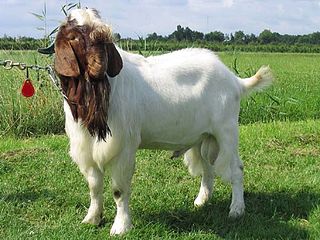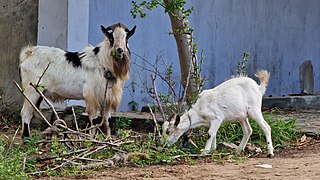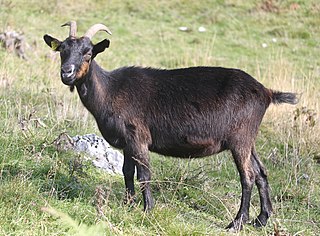
Animal husbandry is the branch of agriculture concerned with animals that are raised for meat, fibre, milk, or other products. It includes day-to-day care, management, production, nutrition, selective breeding, and the raising of livestock. Husbandry has a long history, starting with the Neolithic Revolution when animals were first domesticated, from around 13,000 BC onwards, predating farming of the first crops. During the period of ancient societies like ancient Egypt, cattle, sheep, goats, and pigs were being raised on farms.

The Boer or Boerbok is a South African breed of meat goat. It was selectively bred in the Eastern Cape from about 1920 for meat qualities and for the ability to survive by grazing on the thorn veldt of that region. It has been exported to many countries, and has been used to improve the meat qualities of other breeds.

Capra is a genus of mammals, the goats, comprising ten species, including the markhor and several species known as ibexes. The domestic goat is a domesticated species derived from the bezoar ibex. It is one of the oldest domesticated species of animal—according to archaeological evidence its earliest domestication occurred in Iran at 10,000 calibrated calendar years ago.

The Spanish goat, also called the brush goat or scrub goat, came originally from Spain via Mexico to the United States. It is now a meat and brush-clearing type found widely in the United States. In the Southeast and elsewhere, they are often referred to as "wood" (Florida), "brush" or "briar", "hill" (Virginia), and "scrub" goats. Until recently, these goats were kept mainly for clearing brush and other undesirable plant species from pasture lands. The boer goat had overtaken Spanish goats for meat by the 1980s.

Polled livestock are livestock without horns in species which are normally horned. The term refers to both breeds and strains that are naturally polled through selective breeding and also to naturally horned animals that have been disbudded. Natural polling occurs in cattle, yaks, water buffalo, and goats, and in these animals it affects both sexes equally; in sheep, by contrast, both sexes may be horned, both polled, or only the females polled. The history of breeding polled livestock starts about 6000 years BC.

Goat meat is the meat of the domestic goat. The term 'goat meat' denotes meat of older animals, while meat from young goats is called 'kid meat'. In South Asian cuisine, goat meat is called mutton, along with sheep meat.

Sheep or domestic sheep are a domesticated, ruminant mammal typically kept as livestock. Although the term sheep can apply to other species in the genus Ovis, in everyday usage it almost always refers to domesticated sheep. Like all ruminants, sheep are members of the order Artiodactyla, the even-toed ungulates. Numbering a little over one billion, domestic sheep are also the most numerous species of sheep. An adult female is referred to as a ewe, an intact male as a ram, occasionally a tup, a castrated male as a wether, and a young sheep as a lamb.

The feral goat is the domestic goat when it has become established in the wild. Feral goats occur in many parts of the world.
In Sri Lanka many farmers depend on animal husbandry for their livelihood, but not a large proportion. Therefore, many livestock products have to be imported. The main livestock products in Sri Lanka are milk, meat and eggs. Hides, wools and other products are still not produced within the country. Animal power formerly used in the cultivation of rice and vegetables have been replaced by modern technology to farmlands. However animal husbandry plays an important role in the rural economy for improving the living conditions of farmers in the country.

Cattle are large, domesticated, bovid ungulates widely kept as livestock. They are prominent modern members of the subfamily Bovinae and the most widespread species of the genus Bos. Mature female cattle are called cows and mature male cattle are bulls. Young female cattle are called heifers, young male cattle are oxen or bullocks, and castrated male cattle are known as steers.

American Lamancha, or more commonly, simply Lamancha or LaMancha, is a formally recognized breed of dairy goat, first bred in California by Mrs. Eula Fay Frey about 1927. Later she moved the herd to Glide, Oregon for further development. The Lamancha goat is a member of the Capra genus, specifically Capra aegagrus hircus, like all domestic goats.
Murciana, also called Murcian, Murcien, Murciene and Royal Murciana is a dual-purpose breed of goat originally bred in the Murcia province along the Mediterranean coast of southeastern Spain. The main milk-producing goat breed in Spain is a cross between the Murciana and the Granadina goat known as Murciano-granadina goat. Only the latter is officially recognized by the Spanish government, so Murciana goats are considered a variety of such breed.

The Icelandic goat, also known as the 'settlement goat', is an ancient breed of domestic goat believed to be of Norwegian origin and dating back to the settlement of Iceland over 1100 years ago. This breed of goat was on the verge of extinction during the late 19th century, but recovered prior to World War II, only to precipitously decline again. The population has dropped below 100 animals several times, leading to genetic bottleneck. As of 2003, there were 348 goats in 48 flocks distributed throughout most parts of Iceland. At the end of 2012, the herd had increased to 849. Since this breed has been isolated for centuries, the Icelandic populations are highly inbred. The Icelandic goat is very rare outside its native land. Under its coarse, long guard hair, the Icelandic goat has a coat of high quality cashmere fiber. Icelandic goats are kept mainly as pets and their economic potential for meat, milk, cashmere and skin production remains to be explored. The Icelandic goat is currently of little economic value.
The Aspromonte or Capra dell'Aspromonte is an indigenous breed of domestic goat from the mountain massif of the Aspromonte, in the province of Reggio Calabria in Calabria in southern Italy, for which it is named. It is raised only in the province of Reggio Calabria, mainly in the Aspromonte, in the Altipiano dello Zomaro to the north-east, and in the Ionian coastal areas of the province, and particularly in areas of Grecanic culture. While the breed is thought to originate on the Aspromonte, it may have been influenced by the various other goat breeds, including the Abyssinian goat, the Maltese, and a type known as "Tibetan" with long silky hair, whose importation to Calabria in the early twentieth century is well documented.

Goat farming involves the raising and breeding of domestic goats as a branch of animal husbandry. People farm goats principally for their meat, milk, fibre and skins.

The Manchega is a breed of sheep native to the La Mancha region of Spain. The Manchega is most famous for producing the milk that is used to produce Manchego cheese, a very popular Spanish sheep's milk cheese.

The Istrian Milk is a breed of domestic sheep native to the Karst Plateau and the Istria region in Slovenia, Croatia and Italy. The Istrian Milk is mainly used for its milk, which is primarily used in cheese making. Today, the breed is endangered.

Goat evolution is the process by which domestic goats came to exist through evolution by natural selection. Wild goats — medium-sized mammals which are found in noticeably harsh environments, particularly forests and mountains, in the Middle East and Central Asia — were one of the first species domesticated by modern humans, with the date of domestication generally considered to be 8,000 BC. Goats are part of the family Bovidae, a broad and populous group which includes a variety of ruminants such as bison, cows and sheep. Bovids all share many traits, such as hooves and a herbivorous diet and all males, along with many females, have horns. Bovids began to diverge from deer and giraffids during the early Miocene epoch. The subfamily Caprinae, which includes goats, ibex and sheep, are considered to have diverged from the rest of Bovidae as early as the late Miocene, with the group reaching its greatest diversity in the ice ages.

Drežnica goat is an autochthonous breed of goat, originating in Slovenia, Posočje. Currently it is the only goat breed being listed among Slovenian either autochthonous either traditional breeds of domestic animals. Animals of this breed are middle-sized darker goats, that are being used both for production of milk and dairy products as well as obtaining goat meat.


















































